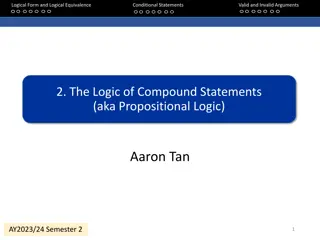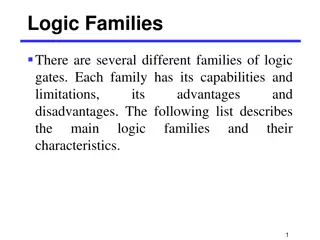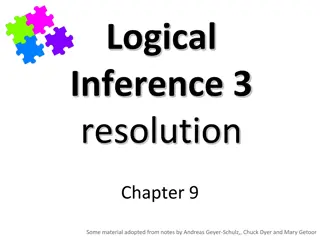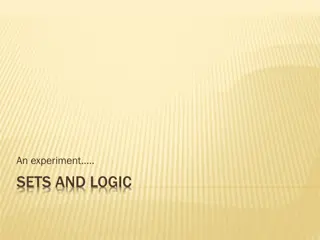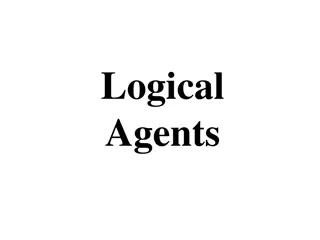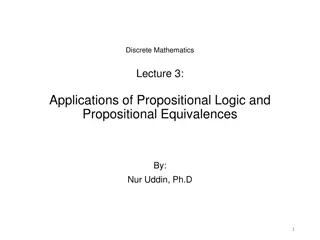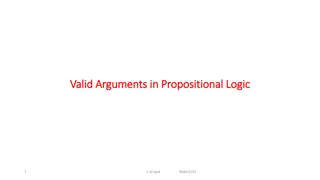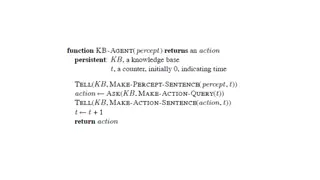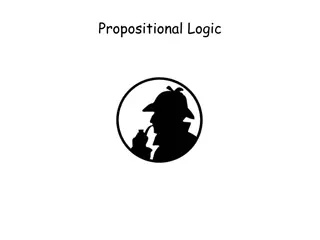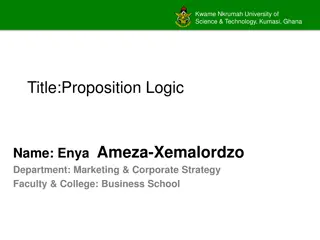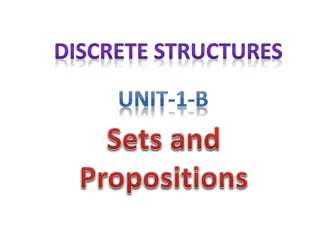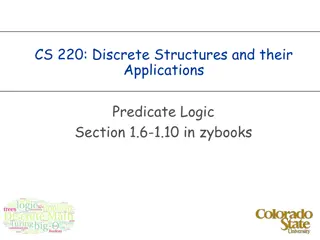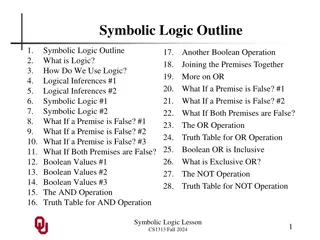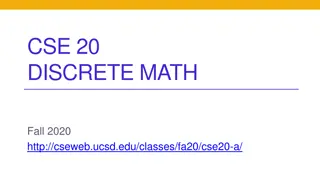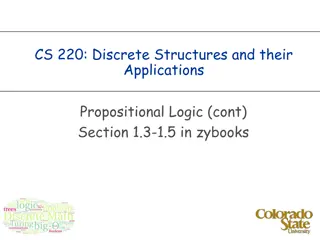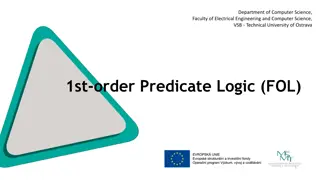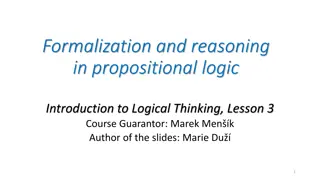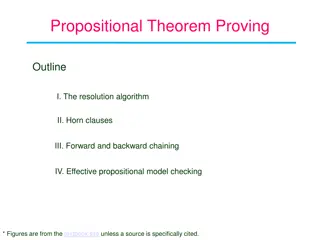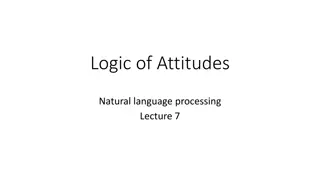Logical Agents and Propositional Logic in AI
Designing logical agents involves forming representations of the world, using inference for deriving new insights, and deducing actions based on these representations. Knowledge Base (KB) is a crucial component, comprising known facts and current percepts to infer hidden states. Propositional logic, involving true/false statements, plays a central role, with syntax and semantics defining logical structures. Entailment and inference are key concepts for deriving conclusions in logical reasoning.
Download Presentation

Please find below an Image/Link to download the presentation.
The content on the website is provided AS IS for your information and personal use only. It may not be sold, licensed, or shared on other websites without obtaining consent from the author.If you encounter any issues during the download, it is possible that the publisher has removed the file from their server.
You are allowed to download the files provided on this website for personal or commercial use, subject to the condition that they are used lawfully. All files are the property of their respective owners.
The content on the website is provided AS IS for your information and personal use only. It may not be sold, licensed, or shared on other websites without obtaining consent from the author.
E N D
Presentation Transcript
Artificial Intelligence Chapter 7: Logical Agents & Propositional Logic In which we design agents that can form representations of the world, use a process of inference to derive new representations about the world, and use these new representations to deduce what to do. Instructor: Zakariya Ahmed Oraibi University of Basrah, Iraq
What is Knowledge Base (KB) Logical Agents Combine: - A Knowledge Base (KB): A list of facts that are known to the agent. - Current Percepts. Thus, KB can be defined as: A set of sentences describing the world. Motivation: To infer hidden aspects of the current state using Rules of Inference
How to Represent KB? Logic: It is a formal language to represent knowledge, which consists of: Which one is more challenging? And why?
How to Represent KB? Words with more than one meaning: - I left my phone on the left side of the room. - The committee chair sat in the center chair. - She will park the car so we can walk in the park.
Propositional Logic The simplest and most abstract logic - A proposition: is a statement that can either be true or false; it must be one or the other but not both. Example: 9 + 5 , 9 is not a prime number - An atomic sentence is one whose truth or falsity does not depend on any other proposition. Note: letters (q, p, O, ) can be used to represent this logic
Semantic - A model specifies the true/ false status of each proposition symbol in the KB.
Entailment - The truth of one sentence follows from the truth of another sentence.
Entailment: Inference Answer 2: We can use deduction theorem: if KB then a
Inference Rules.. NO TRUTH TABLE It is a faster way to implement the inference process by using a proof procedure that uses sound rules of inference to deduce (i.e., derive) new sentences that are true in all cases where the premises are true. Given the sentences in KB, construct a proof that a given conclusion sentence can be derived from KB by applying a sequence of sound inferences using either sentences in KB or sentences derived earlier in the proof, until the conclusion sentence is derived. This step-by-step, local proof process also relies on the monotonicity property. That is, adding a new sentence to KB does not affect what can be entailed from the original KB and does not invalidate old sentences.
Inference Rules.. MEMORIZE P q Can be rewritten as: Because of Implication Elimination P q 1 P q P q 2 Using MP Rule 3 New Rule has been inferenced
Inference Rules.. MEMORIZE P q Can be rewritten as: 2 q Because of Implication Elimination P q P q 1 P 3 Using MT Rule New Rule has been inferenced
Inference Rules.. MEMORIZE p r p r
Inference Rules.. MEMORIZE p r P q Can be rewritten as: q r Can be rewritten as: Because of Implication Elimination Because of Implication Elimination P q q r P q 1 q r 2 Using Syllogism Rule p r 3 p r
Inference Rules.. Example Let s take the weather problem: Prove the conclusion is it raining for the weather problem given above by inference rules.
Inference Rules.. Example Let s take the weather problem: Answer: 1 2 3 4 Modus Ponens (1,2) 5 And Introduction (1,4) 6 Modus Ponens (3,5) Prove the conclusion It is raining for the weather problem given above by inference rules.
Disadvantages of Propositional Logic - Hard to identify "individuals." E.g., Mary, 3. we need a unique symbol for each individual. - Can't directly talk about properties of individuals or relations between individuals. E.g., tall(Bill). - Generalizations can't easily be represented. E.g., all triangles have 3 sides.
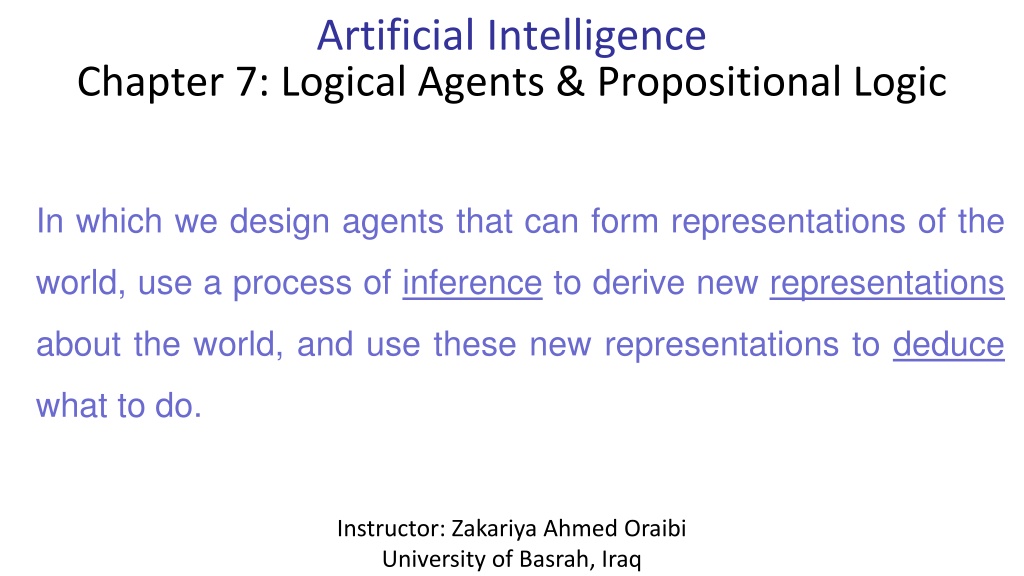
 undefined
undefined
